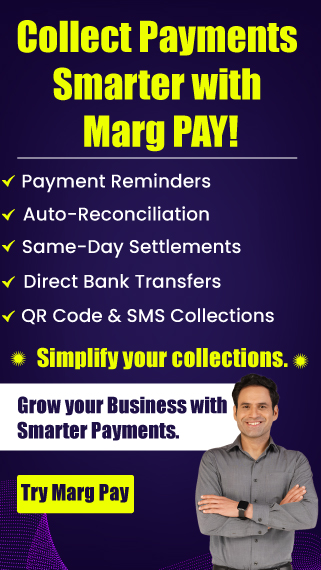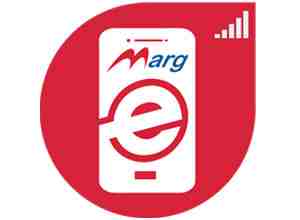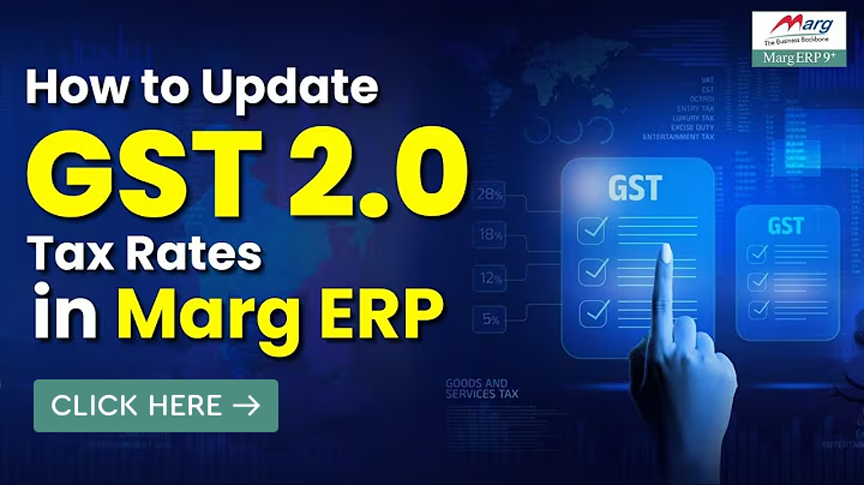Search by Category
- Marg Health QR Code
- Marg Nano
- Swiggy & Zomato
- ABHA - Ayushman Bharat
- Marg Cloud
-
Masters
- Ledger Master
- Account Groups
- Inventory Master
- Rate and Discount Master
- Refresh Balances
- Cost Centre Master
- Opening Balances
- Master Statistics
- General Reminder
- Shortage Report
- Supplier Vs Company
- Temporary Limit
- Shop QRID and eBusiness
- Cloud Backup Setup
- Password and Powers
- Marg Licensing
- Marg Setup
- Target
- Budget
- Credit Limit Management
- Change ERP Edition
- Ease Of Gst Adoption
-
Transactions
- ERP To ERP Order
- Sale
- Purchase
- Sale Return
- Purchase Return
- Brk / Exp Receive
- Scrap Receive
- Brk / Exp Issue
- Scrap Issue
- GST Inward
- GST Outward
- Replacement Issue
- Replacement Receive
- Stock Issue
- Stock Receive
- Price Diff. Sale
- Price Diff. Purchase
- BOM
- Conversion
- Quotation
- Sale Order
- Purchase Order
- Dispatch Management
- ERP Bridger
- Transaction Import
- Download From Server
- Approvals
- Pendings
- Accounts
- Online Banking
-
Books
- Cash and Bank Book
- All Ledgers
- Entry Books
- Debtors Ledgers
- Creditors Ledger
- Purchase Register
- Sale Register
- Duties & Taxes
- Analytical Summaries
- Outstandings
- Collection Reports
- Depreciation
- T-Format Printing
- Multi Printing
- Bank Reconcilation
- Cheque Management
- Claims & Incentives
- Target Analysis
- Cost Centres
- Interest and Collection
- Final Reports
-
Stocks
- Current Stock
- Stock Analysis
- Filtered Stock
- Batch Stock
- Dump Stock
- Hold/Ban Stock
- Stock Valuation
- Minimum Level Stock
- Maximum Level Stock
- Expiry Stock
- Near Expiry Stock
- Stock Life Statement
- Batch Purchase Type
- Departments Reports
- Merge Report
- Stock Ageing Analysis
- Fast and Slow Moving Items
- Crate Reports
- Size Stock
-
Daily Reports
- Daily Working
- Fast SMS/E-Mail Reports
- Stock and Sale Analysis
- Order Calling
- Business on Google Map
- Sale Report
- Purchase Report
- Inventory Reports
- ABC Analysis
- All Accounting Reports
- Purchase Planning
- Dispatch Management Reports
- SQL Query Executor
- Transaction Analysis
- Claim Statement
- Upbhogkta Report
- Mandi Report
- Audit Trail
- Re-Order Management
- Reports
-
Reports Utilities
- Delete Special Deals
- Multi Deletion
- Multi Editing
- Merge Inventory Master
- Merge Accounts Master
- Edit Stock Balance
- Edit Outstanding
- Re-Posting
- Copy
- Batch Updation
- Structure/Junk Verificarion
- Data Import/Export
- Create History
- Voucher Numbering
- Group of Accounts
- Carry Balances
- Misc. Utilities
- Advance Utilities
- Shortcut Keys
- Exit
- Generals
- Backup
- Self Format
- GST Return
- Jewellery
- eBusiness
- Control Room
- Advance Features
- Registration
- Add On Features
- Queries
- Printing
- Networking
- Operators
- Garment
- Hot Keys
-
GST
- E-Invoicing
- Internal Audit
- Search GSTIN/PARTY
- Export Invoice Print
- Tax Clubbing
- Misc. GST Reports
- GST Self-Designed Reports
- GST Return Video
- GSTR Settings
- Auditors Details
- Update GST Patch
- Misc. GST Returns
- GST Register & Return
- GST RCM Statement
- GST Advance Statement
- GST Payment Statement
- Tax Registers and Summaries
- TDS/TCS Reports
- Form Iss./Receivable
- Mandi
- My QR Code
- E-Way Bill
- Marg pay
- Saloon Setup
- Restaurant
- Pharmanxt free Drugs
- Manufacturing
- Password and Power
- Digital Entry
Home > Margerp > Ledger Master > How to Create New Ledger in Marg ERP Software ?
How to Create New Ledger in Marg ERP Software ?
Overview of Ledger Creation in Marg ERP Software
Process of Ledger Creation in Marg ERP Software
Process to Delete Ledger in Marg ERP Software
Process to Modify ledger in Marg ERP Software
Overview of Ledger Creation in Marg ERP Software
- A ledger can be stated as an authenticated account record that can categorize a transaction. The appropriate classification of all ledgers into suitable Groups is essential for appropriateness of Accounting. The classification of groups and ledgers results into Profit & Loss and Balance Sheet.
- The basic purpose of creation of Ledgers in Marg ERP Software is to maintain records of any type of transactions concerning Sale/Purchase/Cash received etc.
- Ledgers can be made as and when it is required or at the time when the transactions are being occurred.
- With the help of ledgers, it becomes easier to view any transaction that has taken place with the specified date.
Process of Ledger Creation in Marg ERP Software
- Firstly, Go to Masters > Ledger Master > Ledger > New Ledger.
- The user will now select the group under which user wants to create ledger. From here the user can create Sundry Debtors i.e. Customers, sundry creditors i.e. suppliers, accounts head like expenses ledger, liabilities ledger, assets ledger etc. except items, sale and purchase.
- In order to create ledger of Customer, select Sundry Debtors ledger from the Under Group window.
The user will select the below options as per the requirement.
a. Ledger Name: The user will mention the name of the Customer/Supplier.
Suppose, mention customer name ‘Om Distributors’.
b. Station: The user will mention the name of the place where the customer belongs i.e. the Location.
Suppose, mention ‘Faridabad’.
c. Account Group: The user has already selected the account group in the beginning like for Customers i.e. Sundry Debtors.
d. Balancing Method: In balancing method, the user will select the 'Adjustment method' that is Bill by bill, FIFO Base and On Account.
- Bill by Bill: It means that the creation of outstanding of the party will be done through Bill by Bill. Hence, whenever the user receives the payment from the customer then against which bill the payment is coming, that window will be displayed, and it will also maintain the outstanding bill by bill.
- FIFO Base: It means First In First Out, It will also maintain the outstanding but when the user will receive the payment from the party then it will not display any window, but whichever is the user’s first or second bill that will be maintained by Software according to the FIFO base.
- On Account: It does not maintain the outstanding of the party and whenever the user will receive the payment from the party then it will not display that against which bill the user has received the payment. The user has to see in the ledger of the party only that how much amount the user has to take from that party.
e. Opening Balance: The user will mention if any amount from the customer is pending then the user will mention that amount in the opening balance.
f. Dr.: The user can choose from here that the pending amount is in Dr. or Cr. If it is customer, then mention the amount in Dr. and if it is a supplier, then mention the amount in Cr.
g. Mail To: The user can view that the software has automatically picked the ledger name that user has entered. Whenever the user will print the bill, then the software will print the name mentioned in Mail to.
h. Address: The user will mention the place where the user belongs.
i. Pin Code: The user will mention the pin code of the place/area where user belongs.
j. E-mail: The user will mention the e-mail address of the party.
k. Website: The user will mention the address/website of the party.
l. Contact Person: The user will mention the first name and the last name of the customer.
m. Designation: The user will mention the designation of the contact person.
n. Phone No. (Off.): The user will mention the phone number(s) of the office/party.
o. Mobile: The user will mention the mobile number of the party.
p. Phone No. (Res.): The user will mention the residential number of the party.
q. Fax No.: The user will mention the Fax number of the party, if any.
r. Freeze Upto: Mention the date till which the user needs to freeze the ledger of the particular party. The user won’t be able to do modification of that ledger until that defined date.
s. Narco/Sch-H Item Billing: This field is compulsory for Pharma trade as there are a few alcoholic influenced medicines for which Drug Department has made different schedules. So, the user can set here whether the user wants to do the billing of different schedules of the drug or not.
t. D.L. No.: The user will mention the Drug license number if any. Also, if the party is not of pharma then the user can disable this field from setup.
u. D.L. No. Exp.: The user will mention the expiry date of the D.L. number.
v. GST Heading: The user will select that for which customer the user is creating the ledger i.e. Local or Central. By default, it is set as “Local”. Also, if the user wants that the software should ask the type then set “Ask local” for local OR ‘Ask Central’ for Central.
w. GSTIN No.: The user will mention the GSTIN number of the party which is issued through the government. The software will select the State automatically on the basis of the GSTIN number.
x. Dt.: The user will mention the date from when the GSTIN number is applicable.
y. VAT Heading: VAT heading is one of the hard coding heading where the user can mention the manual heading as well which would get printed at the time of taking the printout.
z. VAT No.: The user will mention the VAT/TIN Number.
aa. VAT Exp.: The user will mention the expiry date of the VAT/TIN Number.
ab. S.T. Heading: The user will mention the S.T. heading, if any.
ac. S.T. No. : The user will mention the S.T. No., if any.
ad. S.T. Exp: The user will mention the expiry date of S.T. No., if any.
ae. Food Heading: The user will mention the Food Heading, if any.
af. Food No.: The user will mention the Food No., if any.
ag. Food Exp.: The user will mention the Food Expiry date, if any.
ah. Extra Heading: The user will mention the Extra Heading, if any.
ai. Extra No.: The user will mention any Extra No., if any.
aj. Extra Exp.: The user will mention the expiry of that extra number, if any.
Note: In case of only Pharma the user needs to mention all these headings. In case of any other Trade, the user can leave it blank or can disable it from the control room.
ak. I.T. Pan No.: I.T. Pan No. is compulsory by the government that if the party is doing billing in cash like 50,000 or more. The user can enter that Income Tax Pan no. here if any and then it will be printed in the party’s bill.
al. Ebusiness code: The user will select the Ebusiness code here.
am. Note: The user will mention any note for the party that would be printed in the bill.
an. Transfer Data On: The user will select that the data should be transferred on the basis of the GST No. or E-business code.
ao. Ledger Category:The user will select that the ledger has been created for Retailer, Stockiest, Distributors or for Others. By default, this field is set on Others and the user can change it as per requirement.
ap. Color: The user can select color of the ledger if he is a regular customer or you want to indicate any party according to your requirement so you can change the color. By default, it is normal.
aq. State: The software would automatically pick up state when the user will fill the GSTIN no. If the party is unregistered, then press N and a window of State selection will appear from where the user will select the state.
ar. Country: You can change the country from where you belongs. By default, the selected country is India.
as. Ledger Type: If the user has mentioned the GSTIN No., then the software would automatically select the type as Registered. Otherwise, the user can also select accordingly.
If the user is UIN Holder(Unique Identification Number), then select 'UIN Holder' or 'Unregistered' if unregistered, Suppose, if the user has not mentioned the GST number of the party in GSTIN no filed and the user has left from that window so it will Registered by default but after that software would check it in the system with GST no. and then the software will automatically take the ledger of the party as Unregistered.
at. Hide: If the user wants to hide the ledger of any party then select 'Yes', otherwise select 'No'.
Process To Delete Ledger In Marg ERP Software
Note - The user can only delete that ledger which does not contain any transaction in it. However, if user needs to delete the ledger that having transaction then firstly user needs to delete the transaction that have been made with the ledger and after that it can be deleted.
- Firstly, go to Masters > Ledger Master > Ledger > Delete Ledger.
- The user will select ledger and then press 'Delete' key on it.
- Now, the user will click on 'Delete' button.
- The user will select 'Yes' button to delete the ledger.
Process To Modify Ledger in Marg ERP Software
In order to modify the Party Ledger, the user will have to follow certain steps:
- Firstly, go to Masters > Ledger Master > Ledger > Modify Ledger.
- The user will select ledger and then press 'Enter' key on it.
- The user will select 'Ledger Detail'.
- The user will click on 'Modify' button.
After making all the necessary changes in ledger details user needs to press 'Ctrl+W' key to save the changes in Marg ERP Software.


 -
Marg ERP 9+
-
Marg ERP 9+











